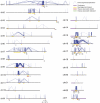Duplication hotspots, rare genomic disorders, and common disease
- PMID: 19477115
- PMCID: PMC2746670
- DOI: 10.1016/j.gde.2009.04.003
Duplication hotspots, rare genomic disorders, and common disease
Abstract
The human genome is enriched in interspersed segmental duplications that sensitize approximately 10% of our genome to recurrent microdeletions and microduplications as a result of unequal crossing over. We review the recent discovery of recurrent rearrangements within these genomic hotspots and their association with both syndromic and nonsyndromic diseases. Studies of common complex genetic disease show that a subset of these recurrent events plays an important role in autism, schizophrenia, and epilepsy. The genomic hotspot model may provide a powerful approach for understanding the role of rare variants in common disease.
Figures



References
-
- Smith AC, McGavran L, Robinson J, Waldstein G, Macfarlane J, Zonona J, Reiss J, Lahr M, Allen L, Magenis E. Interstitial deletion of (17)(p11.2p11.2) in nine patients. Am J Med Genet. 1986;24:393–414. - PubMed
-
- Lupski JR. Genomic disorders: structural features of the genome can lead to DNA rearrangements and human disease traits. Trends Genet. 1998;14:417–422. - PubMed
-
**Key paper defining “genomic disorders” as conditions that result from DNA rearrangements due to regional genomic architecture.
-
- Lupski JR, de Oca-Luna RM, Slaugenhaupt S, Pentao L, Guzzetta V, Trask BJ, Saucedo-Cardenas O, Barker DF, Killian JM, Garcia CA, et al. DNA duplication associated with Charcot-Marie-Tooth disease type 1A. Cell. 1991;66:219–232. - PubMed
-
*CMT1A (duplication of 17p11) and HNPP (deletion of 17p11; ref. 5) were the first two genomic disorders described to result from reciprocal rearrangements mediated by segmental duplications.
-
- Chance PF, Alderson MK, Leppig KA, Lensch MW, Matsunami N, Smith B, Swanson PD, Odelberg SJ, Disteche CM, Bird TD. DNA deletion associated with hereditary neuropathy with liability to pressure palsies. Cell. 1993;72:143–151. - PubMed
-
*CMT1A (duplication of 17p11; ref. 4) and HNPP (deletion of 17p11) were the first two genomic disorders described to result from reciprocal rearrangements mediated by segmental duplications.
Publication types
MeSH terms
Grants and funding
LinkOut - more resources
Full Text Sources

